|
If you make a product, it's reasonable to assume that you
constantly strive to improve the quality of your product.
What do you do first? Instinctively, you review designs for
improvements, seek better materials, optimize processes and
packaging, even improve the customer experience. There are
many paths to improved quality, and you should consider
better testing among the most important.
When we focus on dimensional integrity,
the
Coordinate Measuring Machine is very
often the "grand filter" through which products must pass,
becoming pivotal to the quality function. Yet, when bad
habits emerge, the CMM falls into neglect more than we
realize. Recovery can be a simple matter of getting back to
basics.
Consider the environment your CMM lives in. There is no
point to measuring dirt. Cleanliness is germane to precision
measurement. While every CMM does not have to be in a clean
room, its location must be clean. Allowing the CMM and its
surroundings to become dingy contributes to the feeling that
its purpose is less than important, resulting in
carelessness, increased inspection time, and rejection of
good parts. It's also useful to point out that the CMM is
not a workbench or storage shelf.
Parts being inspected should be clean of chips, burrs,
dirt and oils, for the same reasons. Dirt and oil can
accumulate on a stylus very quickly, introducing errors and
causing stylus wear.
Provide enough lighting so operators can clearly see the
features being measured. The importance of a bright
environment is heightened when creating and testing programs
for inspection, to ensure parts are probed where intended.
Lights also reveal dirt and chips.
Temperature must be controlled in a range that relates to
the material and tolerances measured. In practice, ±5°F
(±2.8°C) is OK for a tolerance of ±0.010" (0.25 mm) over 12"
(305 mm) of cast iron, but it is not good enough for a
tolerance of ±0.001" (0.025 mm) over 12" of aluminum. You
have to do the math—wishful thinking sinks ships.
Energy in the floor will find its way into
CMM
measurements unless it is isolated. Fork trucks driving by,
stamping presses pounding away, even a rail siding outside,
are sources of vibration that can cause trouble. Sources or
processes can be isolated, or the CMM can be placed on
vibration-isolation devices.
Good practice is important. Make sure CMM operators are
properly trained. Often the original trainees are gone, and
subsequent users are left to pick up what they can. Send
operators for CMM and GD&T retraining with some frequency,
and always train new users. Maintain a software service
contract, if it represents good value, for updates and
application support.
Develop procedures or guidelines for CMM use and
CMM
programming to prevent a free-for-all. A good CMM operator
will plan an approach to a new part in advance, whereas many
just start randomly measuring. Efficiency is lost, and
results become suspect. For example, one operator might
measure an ID with four points when the next uses twelve
points. While more data are generally better, guidelines
should be specific for uniformity and repeatability.
Have your CMM professionally serviced and calibrated at
required intervals, including annual preventive maintenance.
Even though you calibrate the styli with the calibration
ball, you should confirm the machine calibration on a more
frequent basis as well. Some measure a "golden part" that
may have been certified, or simply ring or plug gages or
gage blocks, placed in various locations and positions, to
ensure the CMM still measures accurately. Ball bars or step
gages are excellent devices for interim checks of the
Coordinate
Measuring Machine.
Electrical power should, as a minimum, have surge
suppression. An uninterruptible power supply (UPS) is
better. Compressed air, if required, must be clean, dry, and
free of oils, and may require a chiller/dehumidifier and a
two-stage filter. Avoid loading unrelated applications on
the CMM PC, as conflicts can arise.
A casting clamped on a machining fixture with 3000 lbf
(13.3 kN) may well have a different shape when it "rests" on
the CMM for inspection without clamping. Softening clay by
hand to hold a part on the CMM can transfer heat to thinner
sections of the part, and distort its shape. Be realistic in
implementing metrology scenarios lest they come back to bite
you.
If you accept that the CMM is crucial to your quality
efforts, then using it correctly and trusting the results is
mandatory. Adhering to these basics can improve your CMM
utilization, reliability, and (ultimately) your product
quality.
|






